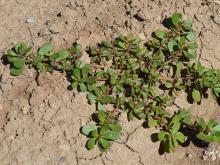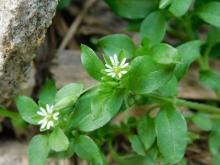Wildflowers, Grasses and Other Nonwoody Plants
Media

Species Types
Scientific Name
Polygonatum biflorum
Description
Solomon's seal grows statewide in moist, rich earth. The greenish-white flowers dangle like little bells beneath the leaves, under the gracefully arching stems.
Media

Species Types
Scientific Name
Sagittaria spp.
Description
Arrowheads are aquatic plants with erect, usually arrow-shaped leaves and distinctive three-petaled flowers. They are often called duck potatoes because ducks, geese, and swans relish the tuberlike rootstocks.
Media

Species Types
Scientific Name
Portulaca oleracea
Description
Purslane can be an aggressive pest in gardens and is one of the worst agricultural weeds in the world. Meanwhile, it’s also a favorite wild vegetable served cooked or raw, and many people cultivate it.
Media

Species Types
Scientific Name
Stellaria media
Description
Common chickweed, native to Europe, has been introduced nearly worldwide and is a familiar garden weed in Missouri. It forms spreading mats on the ground and has small flowers with 5 petals, each deeply lobed making it look like 10.
See Also
About Wildflowers, Grasses and Other Nonwoody Plants in Missouri
A very simple way of thinking about the green world is to divide the vascular plants into two groups: woody and nonwoody (or herbaceous). But this is an artificial division; many plant families include some species that are woody and some that are not. The diversity of nonwoody vascular plants is staggering! Think of all the ferns, grasses, sedges, lilies, peas, sunflowers, nightshades, milkweeds, mustards, mints, and mallows — weeds and wildflowers — and many more!





















